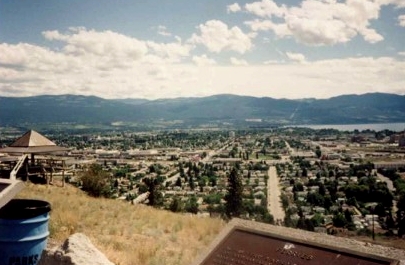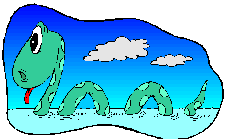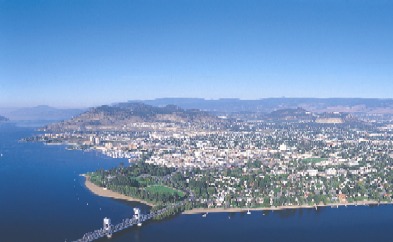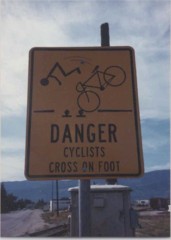
Kelowna
is a city of about 100,000 on the east shore of Okanagan Lake.
The cityís name comes from the local aboriginal language, it
means grizzly bear. The
answer to the obvious question is no, you are not likely to run into any
bears, grizzly or otherwise, wandering the streets downtown, although,
from time to time, black bears have been known to wander into the
outlying areas.
 The
Interior Salish people originally settled the central Okanagan.
The natives have contributed much to the local culture, most
notably the legend of the monster that lives in Okanagan Lake.
They called the creature NíHaatik.
Today we call it Ogopogo, the name, Iím told, comes from a
music hall song popular in the 1920ís.
The
Interior Salish people originally settled the central Okanagan.
The natives have contributed much to the local culture, most
notably the legend of the monster that lives in Okanagan Lake.
They called the creature NíHaatik.
Today we call it Ogopogo, the name, Iím told, comes from a
music hall song popular in the 1920ís.
In
the 1860ís the first Europeans, Catholic missionaries, arrived.
They brought with them the first of the fruit trees that would
decades later become so important to the regionís economy.
The area started out as a cattle producing region but when the
railroad and its sternwheelers arrived and produce was moved more
easily, the focus of agriculture in the valley shifted to irrigated
orchards. Thousands of
acres of arid rangeland were converted to orchards in the first decade
of this century, turning what had been a brown valley, green.
The remains of the primitive, but effective irrigation flumes
that brought melt water from reservoirs high in the hills, can still be
seen on many of the local hillsides.
Kelownaís
town site was laid out in 1892 and the city incorporated in 1905.
Population growth in the area was relatively slow until 1958 when
the Okanagan Lake Bridge, the longest floating span bridge in Canada was
opened. The bridge made
Kelowna much more accessible than the previous ferry service had been,
the road routes to the population and political centres of B.C., the
lower mainland and the capital, are
to the southwest. The
increased growth and accessibility brought tourism to the sunny
Okanagan. Today itís a
crucial part of our economy.

 Like
most Canadians, our lifestyle in the Okanagan is shaped by our climate.
Unlike most Canadians, weíre fortunate to enjoy hot summers and
mild winters, with just enough snow to make you aware that you are in
Canada! The lake is a
natural playground and most native British Columbians have fond memories
of childhood vacations spent on its sandy beaches.
Water sports, golf and recreational team sports are perfect
pastimes in our warm summers and the surrounding mountains provide ample
opportunity to enjoy alpine and cross-country skiing and snowmobiling in
winter. Each summer Kelowna
hosts the (Insert your favourite beer company sponsor here) Thunderfest
Hydroplane races and our local fair, the Regatta.
In January we have a winter fair, Snowfest.
Like
most Canadians, our lifestyle in the Okanagan is shaped by our climate.
Unlike most Canadians, weíre fortunate to enjoy hot summers and
mild winters, with just enough snow to make you aware that you are in
Canada! The lake is a
natural playground and most native British Columbians have fond memories
of childhood vacations spent on its sandy beaches.
Water sports, golf and recreational team sports are perfect
pastimes in our warm summers and the surrounding mountains provide ample
opportunity to enjoy alpine and cross-country skiing and snowmobiling in
winter. Each summer Kelowna
hosts the (Insert your favourite beer company sponsor here) Thunderfest
Hydroplane races and our local fair, the Regatta.
In January we have a winter fair, Snowfest.
The
current planning of the city, and its many green spaces owe themselves
to a little piece of legislation called the Agricultural Land Reserve
Act. The act, passed in the
mid-seventies, protects all viable agricultural land in British Columbia
from development. Much of
the land within the city limits of Kelowna is agriculturally viable and
so, immune to development. This
has presented some interesting vertical sprawl problems for developers,
but at the same time itís preserved much of the beauty that makes this
town so livable. One of the
biggest beneficiaries of the reserve seems to be the golfers in the
community. Due to an
interesting take on the definition of agriculture, golf courses are an
acceptable use for reserve land. By
my count, there are at least 15 courses in and around the city.
Fore!
 Our
city has grown a lot in the last decade, but the leisurely lifestyle
remains entrenched. Our
municipal government has kept a focus on the environment and makes it a
policy to encourage us to eschew our cars for more environment friendly
modes of transportation. Bike
lanes and footpaths abound in the city.
The city works people even go so far as to help out those of us
who are smart enough to keep a bicycle upright but too stupid
(apparently) to know how to
take it across the railroad tracks.
Our
city has grown a lot in the last decade, but the leisurely lifestyle
remains entrenched. Our
municipal government has kept a focus on the environment and makes it a
policy to encourage us to eschew our cars for more environment friendly
modes of transportation. Bike
lanes and footpaths abound in the city.
The city works people even go so far as to help out those of us
who are smart enough to keep a bicycle upright but too stupid
(apparently) to know how to
take it across the railroad tracks.
Go
to Page 2 to see a few of my favourite
things to do in the Okanagan